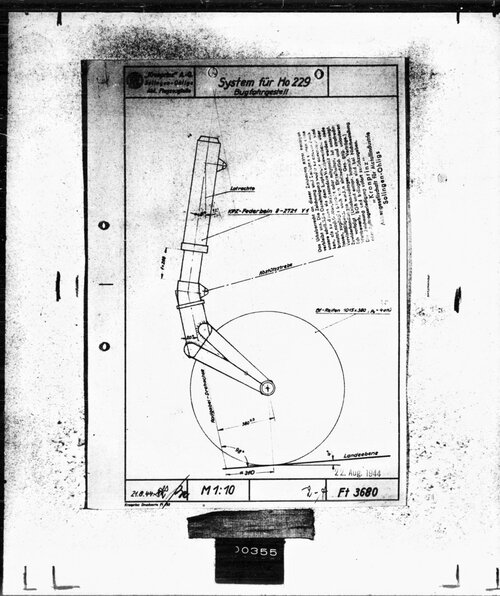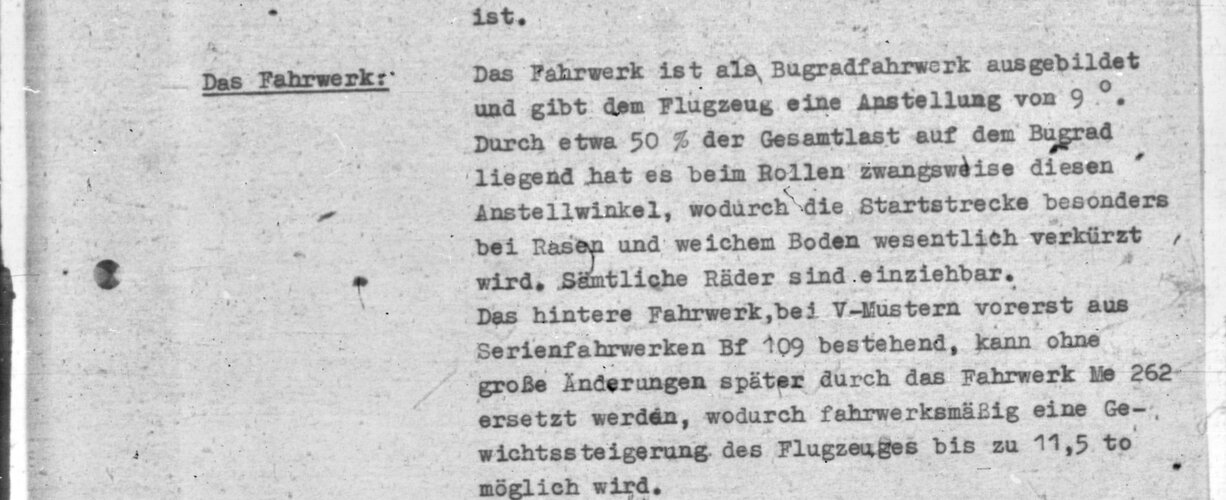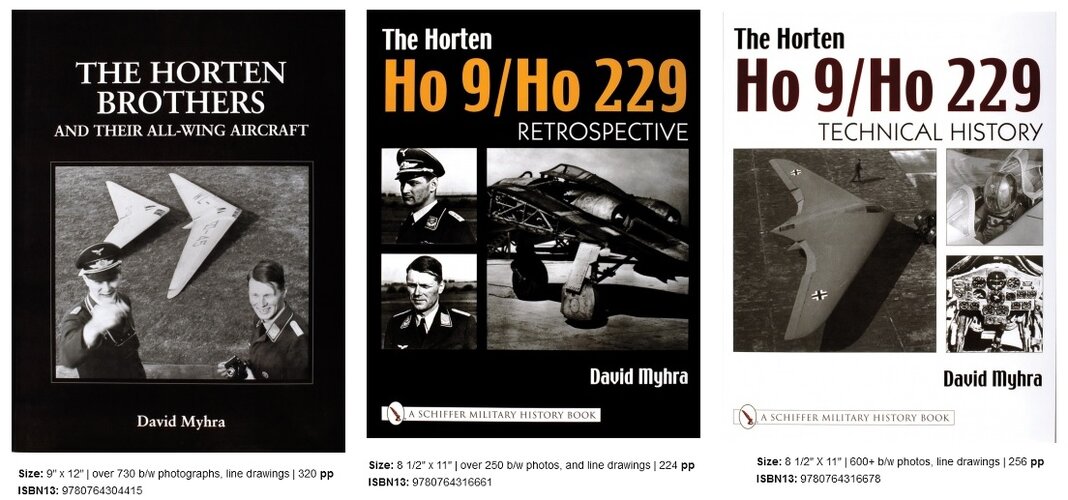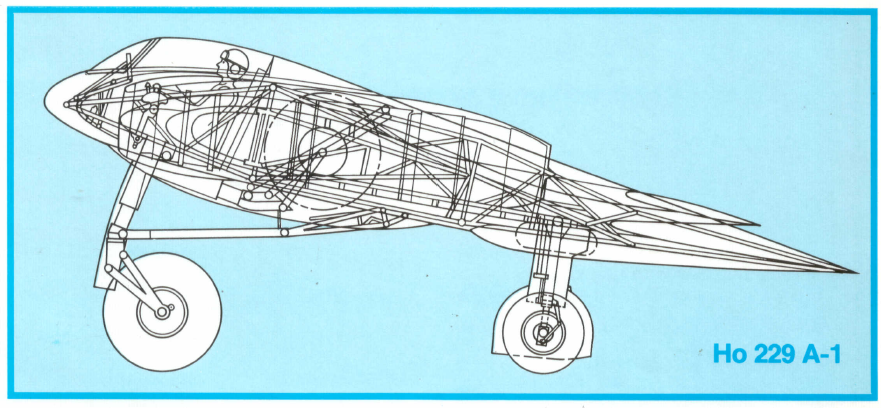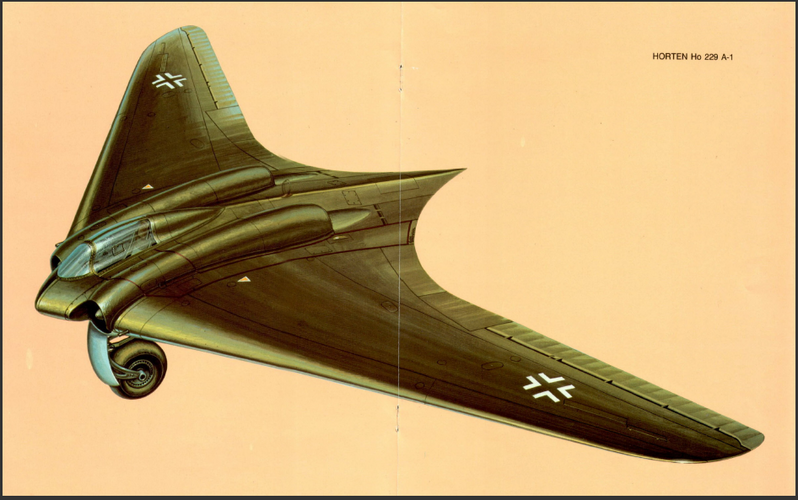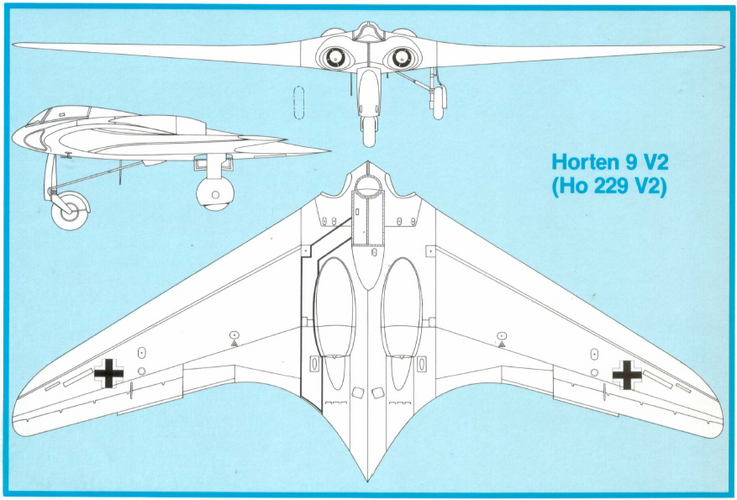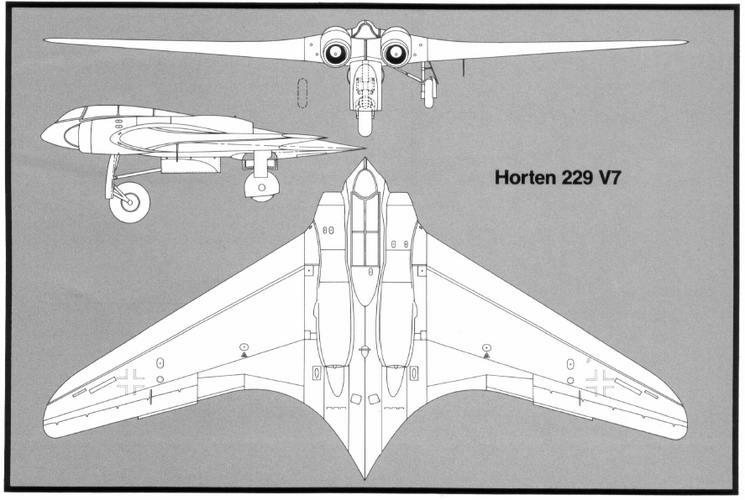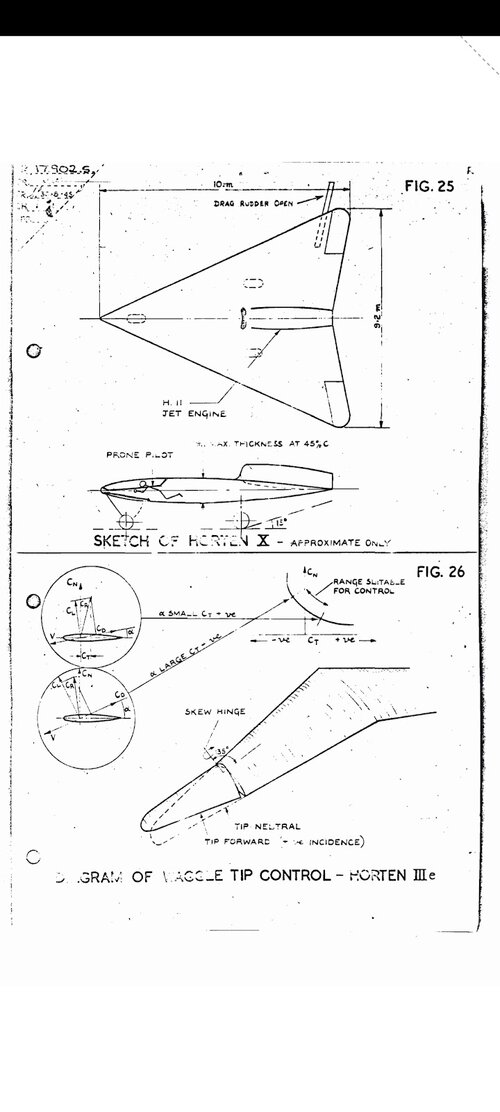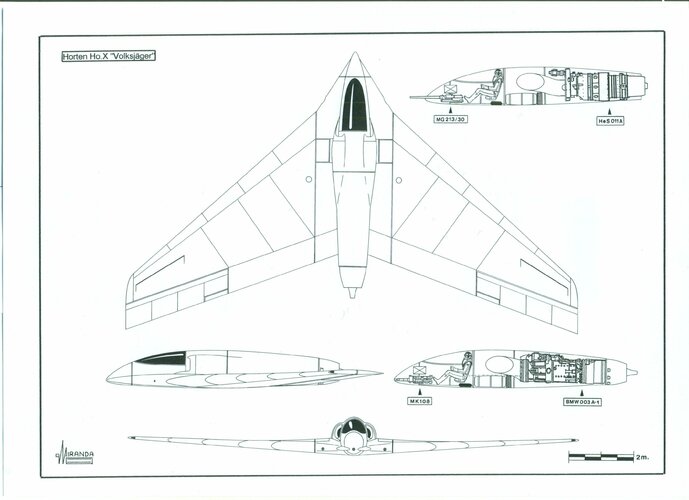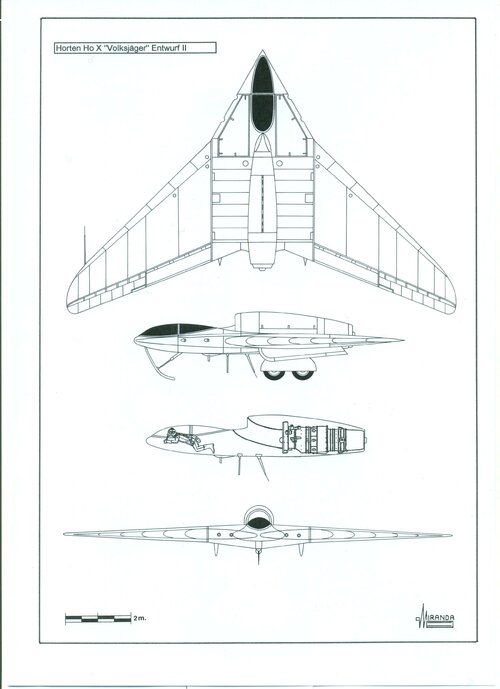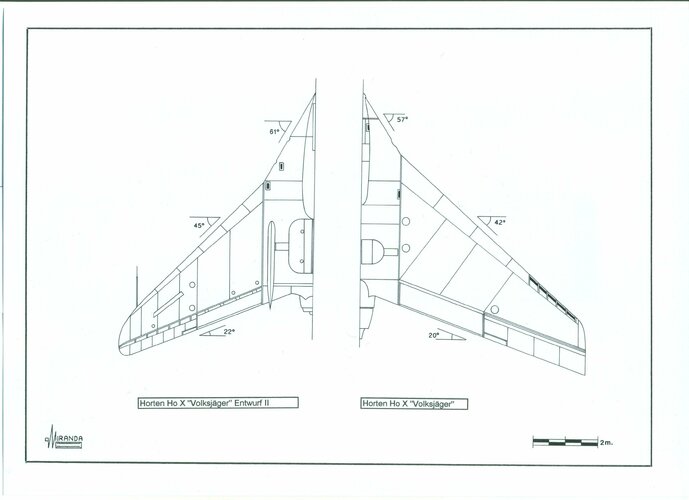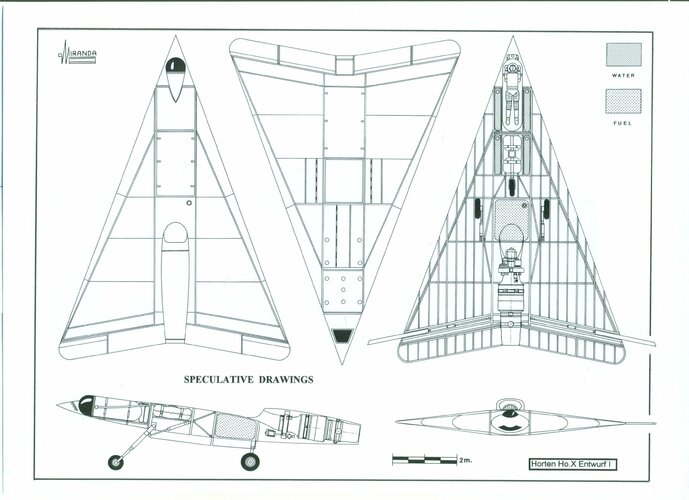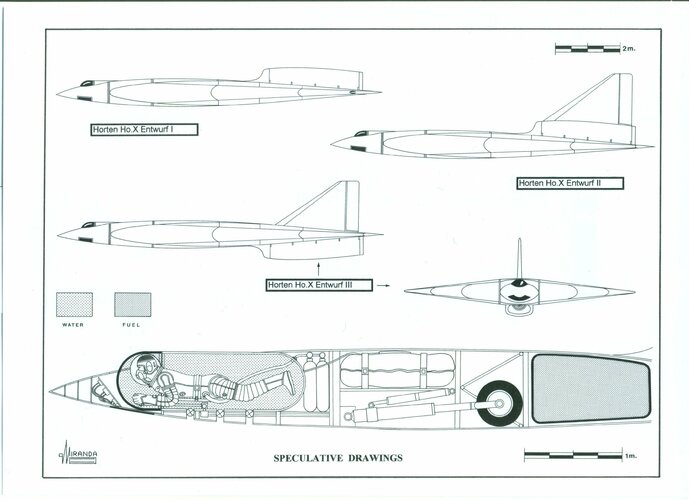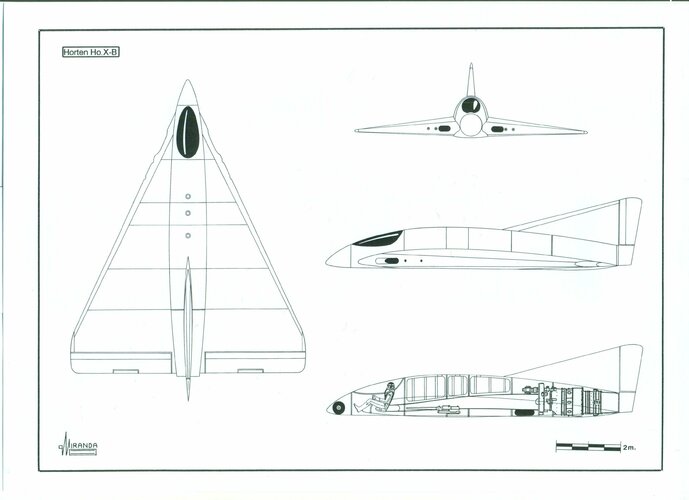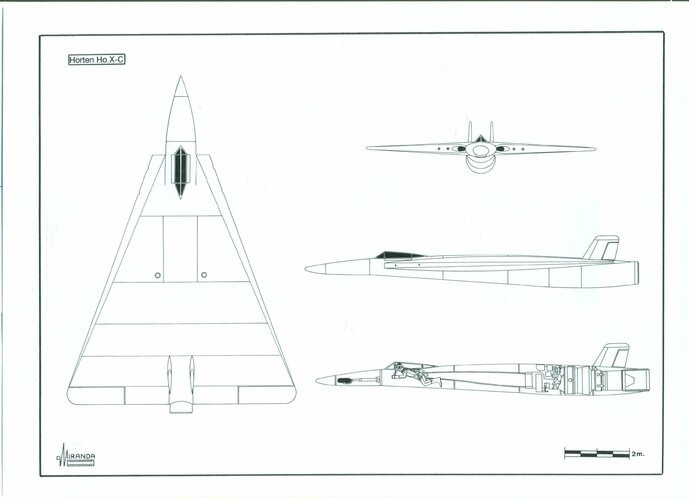Horten Ho X Series
During the two last years of the war, an ultra secret research program was developed in Germany under the name
Hochstgeschwindigkeit (HG) Programm with the objective o finding aerodynamic solutions to the problem of the
compressibility buffeting. The Messerschmitt firm proposed to refine the basic aerodynamic design of the Me 262 in a series of "HG" projects and prototypes. Besides, new shapes of wings, fuselages and air intakes used in the air superiority fighters P.1106, 1110, 1111 and 1112 were tried. The construction of a rocket airplane, specifically designed for transonic flight tests, was also proposed. It was a variant of the P.1106 named P.1106 R which may be considered the equivalent to the American Bell X-1.
The designer Alexander Lippisch proposed the construction of a delta ramjet plane named P.12 and two delta rocket planes; the DM-2, for transonic flight testing, and the DM-3, for supersonic flight testing. The DFS technical team started the construction of the DFS 346 in 1945. It was a swept winged rocket transonic plane, able to research transonic flight, which finally flew under Soviet control after the war.
All these airplanes should use very powerful engines (some ramjets produced up to 60000 h.p.) to overcome the increasing air drag in their approach to the mythical
sound barrier.
As opposed to this
brute force solutions, the Horten thought that a small airplane, aerodynamically perfect, propelled by a single turbojet of 1300 kp, could be built with non-strategic materials to obtain performance data on the transonic flow during a series of flights in gentle dive. This project was also named Ho X to make the intelligence service of the Allied believe that it was the
Volksjäger design. It had a 70º swept delta wing built of plywood and steel tubing with the pilot in prone position and the turbojet installed within the central section with a dorsal air-intake.
The bad transonic experience suffered on 6th of July 1944 by the Me 163 V18 prototype during a flight testing in which almost the entire rudder of the aircraft had been ripped away when reaching 702 m.p.h. suggested the Horten the possibility of avoiding the vibrations and drag produced by the tailfin, effectively removing the latest. The yaw control was obtained in the Ho X by retractable drag rods located in the wingtips.
The small airplane, with just 7.2 of span, needed to have a long runway and a great consumption of fuel to take off by its own means. Therefore, it had to be transported in Mistel configuration by a specialized airplane. The launch should be made at an altitude of 8000 m and the Ho X would then climb on its own until the 15,000 m. At that point, it started a shallow dive, progressively increasing the speed until a theoretical limit of 1195 km/h (Mach 1.07) at 6000 m
To protect the pilot from the highly destructive vibrations, expected to be encountered during the transonic phase of the flight, the Horten considered the use of a fantastic device known as
Wasserkabine (water-cockpit). Although the knowledge on the
Wasserkabine is almost null, it seems to have been a type of ejectable survival capsule. It was full of water during the critical phase of the flight, to protect the pilot (in prone-position and equipped with a full-pressure suit
Druckanzug) from the vibrations and from the extreme physical conditions expected to exist in case of ejection at high altitude.
Supposedly, there should have been a fast disconnection system of the flying controls and no electronic equipment within the cockpit, except for the telephone wire to communicate with the launch airplane. The forward section of the
Wasserkabine should allow a certain degree of visibility to see the instrument board located outside the water-cockpit and downwards. Thus the pilot could see the runway during landing with the characteristic raised AOA of the delta planes.
To prevent the discomfort and great reduction of visibility produced by the water, it is possible that the filling up of the
Wasserkabine were made little before the launch either by pumping water from the mother airplane or perhaps transferring it to the
Wasserkabine from some ballast tanks located in the Ho.X
An approximate estimation of the weight of the water would be around 400 kg which accumulating in the forward part of the airplane would make it a bit heavy on the nose. This feature might be useful during dive flight but would make things very difficult at landing. It seems reasonable to think that the water was pumped outside to improve the exterior visibility and reduce weight before landing. A similar procedure was used to drop the water ballast during the test flights of the
Reichenberg, the piloted version of the V-1.
Some speculative drawings, showing the possible organization within the Ho.X, state only the opinion of the author. The Ho.X project started with a series of test flights made of balsa wood scale models in Hornberg and Göttingen. Afterwards, the construction of a wooden glider (1/1 scale) was started to investigate the subsonic handling and landing problems, although the work was not yet finished by the end of the war in Europe.
The plan was to install a conventional Argus engine pusher to make dive flying tests until reaching a maximum speed of 500 km/h. The next phase of the project would have consisted of building the prototype (Ho.X Entwurf I) equipped with a He S 011 turbojet and
Wasserkabine for the transonic flight testing. Prior studies made with the control system proved that the drag rods could not be extended and retracted fast enough during flight at high speed.
The Entwurf II variant, with a tailfin located over the turbojet, was then designed. The aerodynamic tests made in wind tunnel proved that the engine had many possibilities to stop during landing at high AOA as the air intake stayed within the aerodynamic shadow produced by the nose.
The Entwurf III configuration appeared at this point with tailfin and the air intake in ventral position. Such precautions proved to be unfounded when a very similar British airplane named Handley Page H.P. 115 flew in 1961 equipped with a dorsal air intake without any stops of the engine.
The book
The Horten Brothers by Dr. David Myhra, published in 1998, revealed among other unknown projects, the existence of the Horten Ho X-B, a project on which only two pictures of a 1/72 scale model have been published. It seems to be a combat version of the Ho-X, somehow slower and more maneuverable with 60º delta wing and a
strahlruder in the exhaust nozzle. Some scale drawings based in the pictures, rebuilding the inside in a speculative way, are based on the author personal experience and on the known data of other similar designs.
The book
Jet Planes of the Third Reich, the Secret Projects by the German historian Manfred Griehl was also published in 1998, including a three view drawing of an airplane named
Horten Ho 13-C. In the author opinion, it is a third supersonic version of the Ho X with reheated HeS 011 B engine and expansive conical nozzle.
According to the hypothetical reconstruction of the inside that we show in our drawings, it is possible that the pilot would not be in prone position but in a semi-prone "praying mantis" position, more fitted for air combat and that had been already used in the Ho IV seaplane. It is probably more accurate to name this project as Ho X-C as it clearly is derived from the Ho X without any structural relationship with the swept winged Ho XIII interceptor.
Technical data Volksjäger I
Engine Type BMW 003 E
Engine Power 900 kp
Usage Fighter
Stage Model
Structure steel & wood
Wingspan 14 m
Length 7.2 m
Height 2.3 m
Pilot seated
Wing Area 35 sqm
Sweep 43º / 60º
Thickness -
Empty Weight -
Max Weight 6075 kg
Wing Loading 173.6 kg/sqm
Stall Speed -
Landing Speed -
Max Speed Level -
Max Speed Dive Armament 1 Mk 108/30 2x MG 131
Ceiling -
Range -
Technical data Volksjäger II
Engine Type HeS 011
Engine Power 1300 kp
Usage fighter
Stage drawing
Structure steel & wood
Wingspan 14 m
Length 7.2 m
Height 2.3 m
Pilot seated
Wing Area 35 sqm
Sweep 43º / 60º
Thickness -
Empty Weight -
Max Weight 6000 kg
Wing Loading 171.4 kg/m2
Stall Speed -
Landing Speed 100 km/h
Max Speed Level 1100 km/h
Max Speed Dive -
Armament 1 Mk 213/30 2x MG 131
Ceiling 15000 m
Range 2000 km
Technical data Ho X Glider 1st
Engine Type -
Engine Power -
Usage research
Stage prototype
Structure wood
Wingspan 7.2 m
Length 10 m
Height 2.38 m
Pilot prone
Wing Area 37.8 m2
Sweep 70º
Thickness 7%
Empty Weight 300 kg
Max Weight 400 kg
Wing Loading 10.5 kg/m2
Stall Speed –
Technical data Ho X Glider 2nd
Engine Type As 10C
Engine Power 240 hp
Usage Research
Stage Project
Structure wood
Wingspan 7.2 m
Length 10 m
Height 2.38 m
Pilot prone
Wing Area 37.8 sqm
Sweep 70º
Thickness 7%
Empty Weight 600 kg
Max Weight 700 kg
Wing Loading 18.5 kg/sqm
Stall Speed 56 km/h
Landing Speed 88 km/h
Max Speed Level -
Max Speed Dive 500 km/h
Armament none
Ceiling -
Range -
Technical data Ho X – A
Engine Type HeS 011
Engine Power 1300 kp
Usage research
Stage project
Structure steel & wood
Wingspan 7.2m
Length 10 m
Height 2.38 m
Pilot prone
Wing Area 37.8 sqm
Sweep 70º
Thickness 7%
Empty Weight -
Max Weight 7000 kg
Wing Loading 185 kg/sqm
Stall Speed -
Landing Speed -
Max Speed Level 1000 km/h
Max Speed Dive 1200 km/h
Armament none
Ceiling 15000 m
Range 2000 km
Technical data Ho X – B (probable)
Engine Type HeS 011
Engine Power 1300 kp
Usage fighter
Stage project
Structure steel & wood
Wingspan 7.2 m
Length 9.8 m
Height -
Pilot seated
Wing Area -
Sweep 65º
Thickness -
Empty Weight -
Max Weight -
Wing Loading -
Stall Speed -
Landing Speed -
Max Speed Level -
Max Speed Dive -
Armament 4 x Mk 213/30
Ceiling -
Range –
Technical data Ho X – C (probable)
Engine Type HeS 011B
Engine Power 1500 kp
Usage fighter
Stage project
Structure steel & wood
Wingspan 7.2 m
Length 12 m
Height 2.25 m
Pilot semi prone
Wing Area 37.8 sqm
Sweep 70º
Thickness 7%
Empty Weight -
Max Weight -
Wing Loading -
Stall Speed -
Landing Speed -
Max Speed Level -
Max Speed Dive -
Armament 4 x Mk 213/30
Ceiling -
Range -

